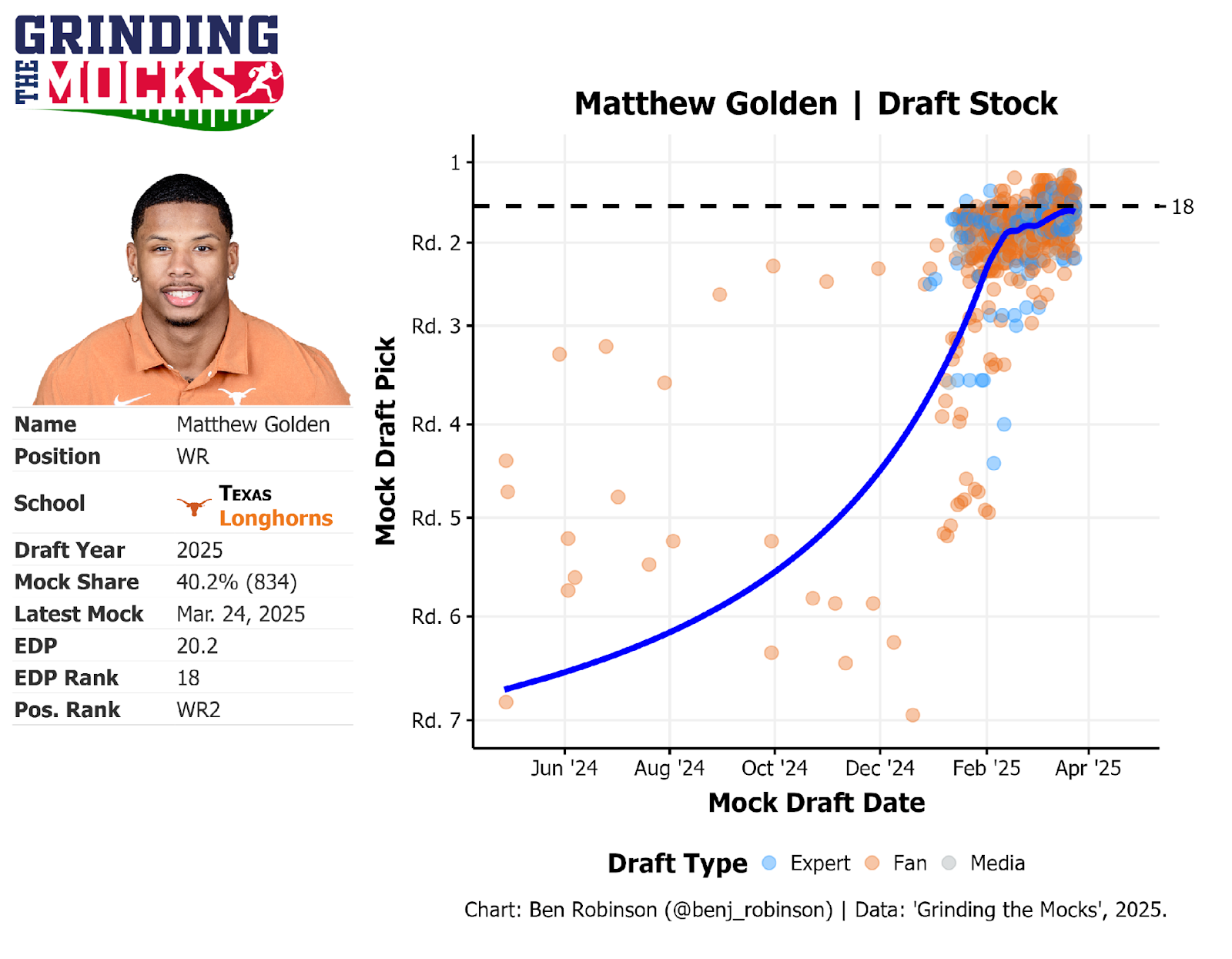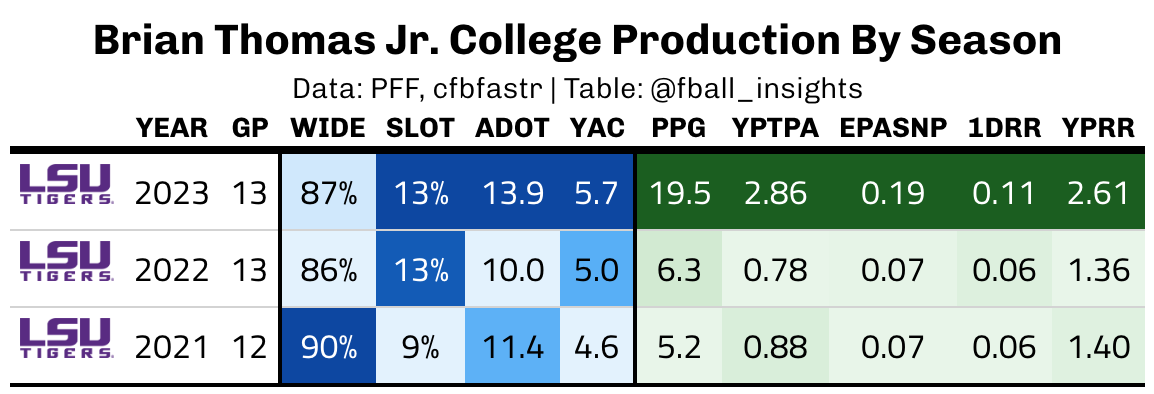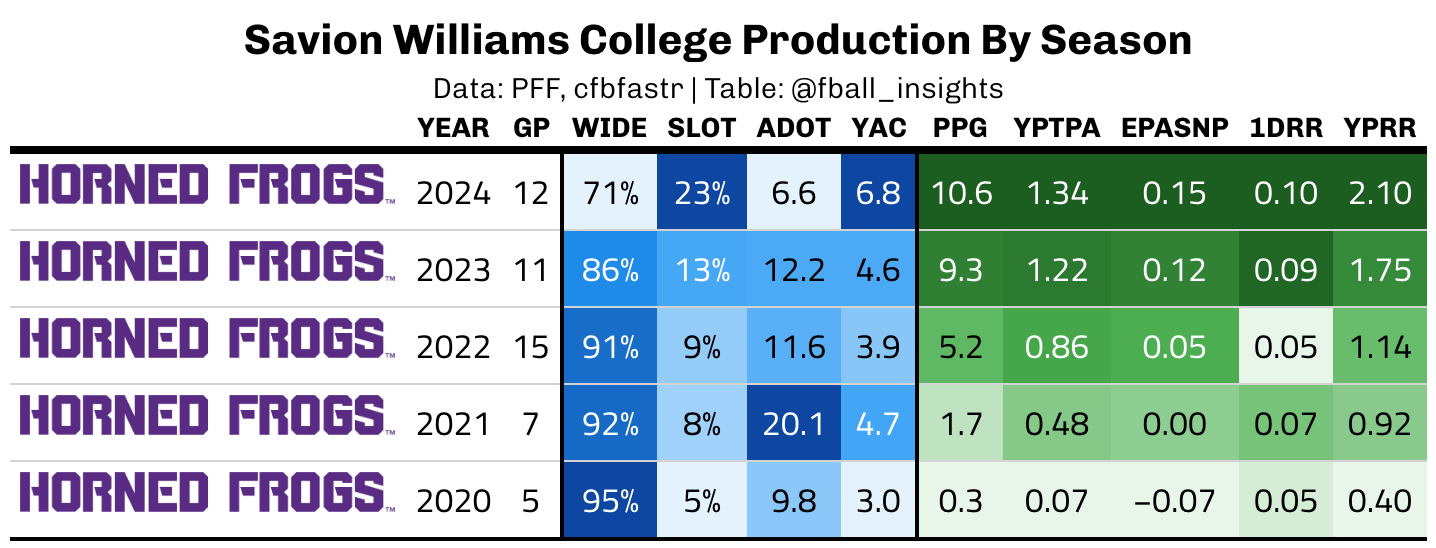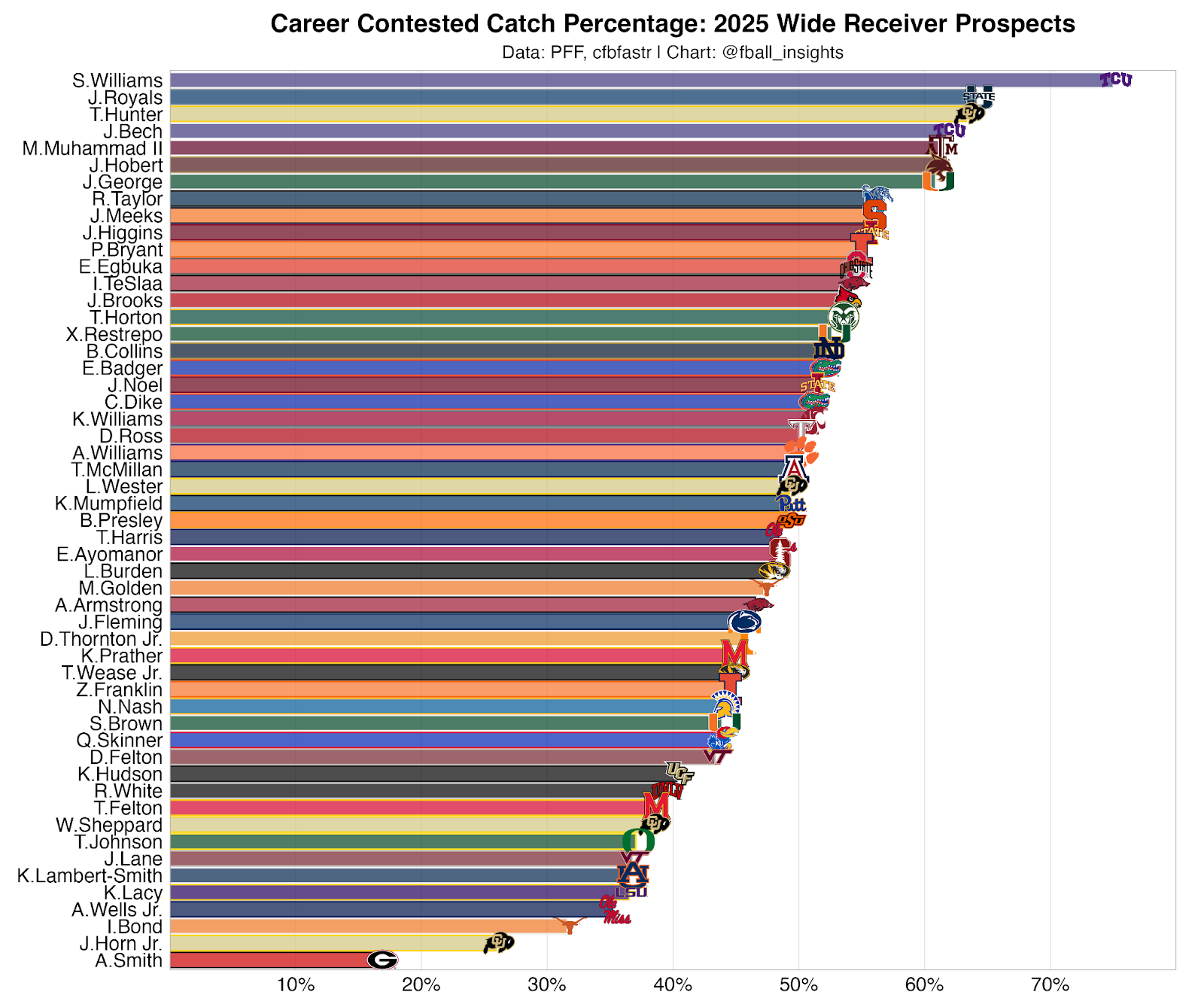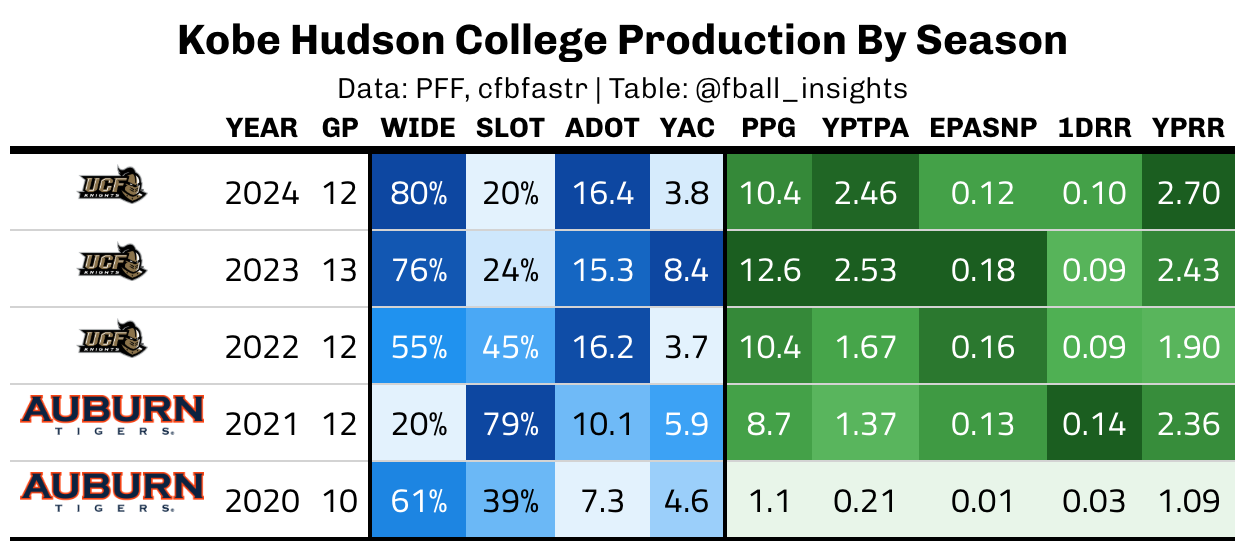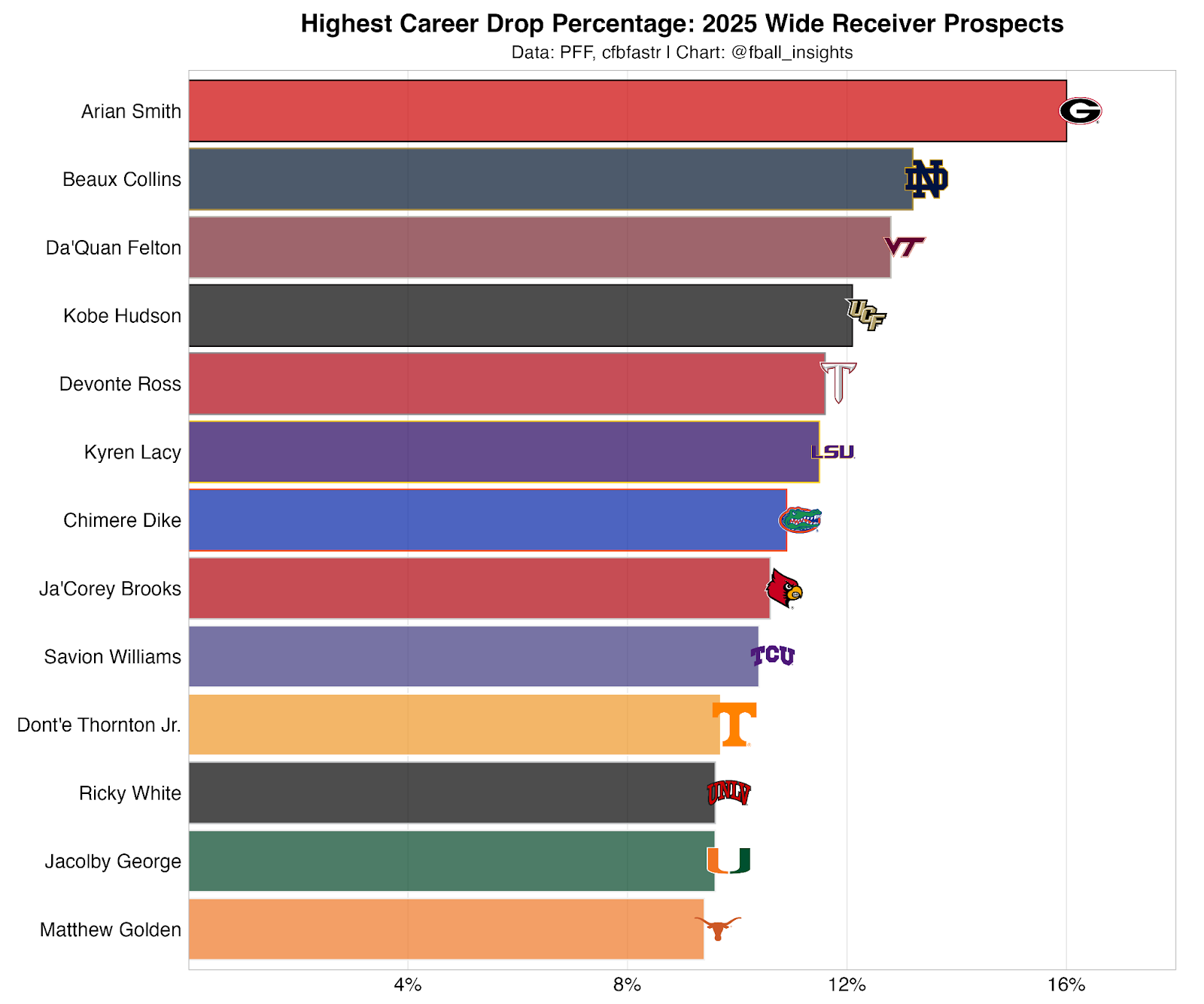This piece marks the third edition of my 2025 NFL Draft wide receiver prospect series published throughout the offseason. You can find the most recent one here.
A quick note: I feature a WR in each “tier” in these writeups. Tiers are centered around public consensus and projected draft capital. I generally dive into their production relative to that and then analyze from there.
Tier 1: Matthew Golden | Texas
Height: 5’11” | Weight: 191 | Age: 21.6
Golden played in three college seasons from 2022-2024. His first two came at Houston, before he transferred to Texas for his final season in 2024.
He is projected to be a first-round pick and the second WR off of the board in April’s draft.
Golden is quite the late riser for a WR garnering Round 1 draft capital. His stock had been on a steady climb dating back to last summer before exploding as the 2024 college season progressed:
Here is Golden’s year-over-year production:
None of Golden’s individual seasons were uber-productive on their own. In my opinion, his play in marquee matchups towards the end of this past season swung the door wide open for first-round dialogue in the public square (PFF):
Weeks 1-14:
1.66 YPRR
1.43 YPTPA
0.16 TPRR
48.0 YPG
13.5% Target Share
Last 4 games (Clemson, Georgia, Arizona State, Ohio State):
3.37 YPRR
2.96 YPTPA
0.24 TPRR
102.8 YPG
21% Target Share
Although Golden popped off against some of the best competition you could ask for, his earlier 2024 numbers and Houston production just don’t meet the Round 1 threshold you would expect:
Golden ran a 4.29 40 at the NFL Combine and tested out well in other areas, but he didn’t do explosive testing like the broad jump or vertical. He also isn’t the biggest receiver for a guy primarily lined up on the outside. His contested-catch abilities were concerning up until his final year.
2022: 37.5% Contested Catch Rate
2023: 30.0% Contested Catch Rate
2024: 61.1% Contested Catch Rate
Matthew Golden’s 1.85 career YPRR would rank as the lowest by a Round 1 WR since Xavier Legette (1.75).
Some folks have tagged Brian Thomas Jr. as a reason to fade any Golden production questions up to date.
I get it — point at another young, athletic prospect who's fresh in our minds, someone who “beat the odds” achieving fantasy prowess despite subpar college production as a first-round selection.
While I was wrong about BTJ, I still think that is flawed thinking as it pertains to Golden. I'll still play both sides of the coin.
Golden did produce 10+ half-PPR points per game during every college season. He is better than the 50th percentile career HPG among all drafted WRs since 2019 (PFF).
Of that qualifying crop of WRs, the following ones own the lowest career targets per route run:
D.K. Metcalf (.177)
Brian Thomas Jr. (.181)
Matthew Golden (.188)
That was an interesting pull. Those guys all tested well at the combine, but could Matthew Golden simply not be getting targeted enough? With first-round draft capital opportunity certainty, could he finally blow the doors on production in the right offense?
I’m not so sure. Metcalf and Thomas Jr. played alongside some dogs in A.J. Brown at Ole Miss and Malik Nabers at LSU, contributing to the lower target rates.
Another reason is usage. In college, Thomas Jr. had a 5.1% screen target percentage, Metcalf had 5.9%, and Golden had 16.8%.
Brian Thomas Jr. 35.4% screen rate as a rookie. 5.1% throughout college (PFF)
— Football Insights 📊 (@fball_insights) February 21, 2025
Further, Metcalf and Thomas Jr. cleared 14 PPG and 2.0 YPTPA during their best seasons, while Golden (11.4 and 1.83) didn’t clear that level of output during his:
There are certainly things to like in Golden's profile. He’s a “true junior” with room to grow, blazing speed, and impressive footwork that all come together when you watch him play. He also did it against the best competition on the biggest stage in 2024.
I’m just not sure he can consistently produce WR1 output over long time horizons at the next level, as we have yet to see it up to this point. I’m interested to see where he lands in the draft!
Tier II: Savion Williams | TCU
Height: 6’3” | Weight: 222 | Age: 23.4
Williams played all five of his college seasons at TCU.
Williams is a projected Day 2 WR slated to be picked at the end of Round 3.
His overall production is alarmingly poor, given his expected draft capital and the fact that he’ll turn 24 years old as a rookie.
Here is his year-over-year receiving production:
Williams owns a 1.56 career yards per route run (PFF).
Among Day 2-3 selections since the 2019 draft, only the following WRs own a lower career YPRR than Williams:
| Name | School | Draft | Round | YPRR |
| Jalen Brooks | South Carolina | 2023 | 7 | 1.28 |
| Ben Skowronek | Notre Dame | 2021 | 7 | 1.31 |
| Casey Washington | Illinois | 2024 | 6 | 1.32 |
| Joshua Palmer | Tennessee | 2021 | 3 | 1.42 |
| Michael Woods | Oklahoma | 2022 | 6 | 1.47 |
| Jonathan Mingo | Ole Miss | 2023 | 2 | 1.48 |
| Hunter Renfrow | Clemson | 2019 | 5 | 1.51 |
| Devaughn Vele | Utah | 2024 | 7 | 1.51 |
| Justin Shorter | Florida | 2023 | 5 | 1.55 |
| Jalen Hurd | Baylor | 2019 | 3 | 1.55 |
| Savion Williams | TCU | 2025 | - | 1.56 |
And the following WRs are the only players with a lower career Receiving PPG (Half-PPR):
| Name | School | Draft | Round | Half PPG |
| Jalen Camp | Georgia Tech | 2021 | 6 | 3.5 |
| Racey McMath | LSU | 2021 | 6 | 4.0 |
| Casey Washington | Illinois | 2024 | 6 | 4.4 |
| Cornell Powell | Clemson | 2021 | 5 | 4.5 |
| Tyrie Cleveland | Florida | 2020 | 7 | 4.7 |
| Derius Davis | TCU | 2023 | 4 | 4.8 |
| Freddie Swain | Florida | 2020 | 6 | 4.8 |
| Jalen Brooks | South Carolina | 2023 | 7 | 5.0 |
| Joshua Palmer | Tennessee | 2021 | 3 | 5.2 |
| Velus Jones | Tennessee | 2022 | 3 | 5.2 |
| Juwann Winfree | Colorado | 2019 | 6 | 5.2 |
| Tre Tucker | Cincinnati | 2023 | 3 | 5.3 |
| Justin Shorter | Florida | 2023 | 5 | 5.4 |
| Terry Godwin | Georgia | 2019 | 7 | 5.8 |
| Anthony Gould | Oregon State | 2024 | 5 | 5.8 |
| Riley Ridley | Georgia | 2019 | 4 | 5.8 |
| Lynn Bowden | Kentucky | 2020 | 3 | 5.8 |
| Cornelius Johnson | Michigan | 2024 | 7 | 5.8 |
| Jha'Quan Jackson | Tulane | 2024 | 6 | 5.9 |
| Jalen Hurd | Baylor | 2019 | 3 | 6.1 |
| Miles Boykin | Notre Dame | 2019 | 3 | 6.1 |
| Tejhaun Palmer | UAB | 2024 | 6 | 6.2 |
| Frank Darby | Arizona State | 2021 | 6 | 6.2 |
| Ben Skowronek | Notre Dame | 2021 | 7 | 6.3 |
| Elijah Higgins | Stanford | 2023 | 6 | 6.3 |
| Devaughn Vele | Utah | 2024 | 7 | 6.3 |
| Antoine Green | North Carolina | 2023 | 7 | 6.4 |
| Bo Melton | Rutgers | 2022 | 7 | 6.4 |
| Savion Williams | TCU | 2025 | - | 6.4 |
It’s incredibly difficult to imagine Williams producing at a high level in the NFL … at wide receiver.
What helps drive his value and potential draft position is his versatility and athleticism at his size.
Williams had 51 rush attempts, 322 rushing yards and 6 rushing touchdowns in 2024. 16% of his total offensive snaps came out of the backfield or from the QB alignment (PFF).
He was a threat in Wildcat and is a mawler with the ball in his hands. As a rusher, Williams forced 0.43 missed tackles per carry and forced 0.36 per offensive touch during the 2024 season.
Williams also has reps as a returner on special teams. According to PFF, he recorded 29 kickoff returns as a freshman in 2020, 3 combined kickoff returns from 2021-2023, and 7 returns during his final season. Perhaps a pivot back to special teams occurred to show what he could/was willing to take on at the next level.
As a pass catcher, Savion Williams has phenomenal contested catch abilities. Williams owns a whopping 75% career contested catch rate.
Not only is that the best in this year’s draft, but it’s also the highest among all drafted WRs since 2021 with at least 10 contested opportunities (PFF).
Williams has unique skills and athleticism given his 6’3”, 220-pound frame. He has earned legitimate volume as a rusher and elite success rates in contested situations as a receiver.
If Williams were to succeed at the next level, it would likely occur through high-variance fantasy performances in a Cordarrelle Patterson type of role.
Tier III: Kobe Hudson | UCF
Height: 6’1” | Weight: 193 | Age: 22.6
Hudson began college at Auburn in 2020, where he played his first two seasons before transferring to UCF in 2022 to play his final three seasons.
Hudson is projected to be a Day 3 pick. Here is his year-over-year production:
In 2024, Hudson notched 88 targets, which led UCF by a wide margin.
Four different UCF QBs recorded at least 100 dropbacks throughout Hudson’s final two years, which isn’t exactly a recipe for continuity as a receiver. He still posted 2.54 YPRR and 113.5 YPG over this time frame.
With all of that considered, you could still argue that Hudson’s most impressive year came as a sophomore at Auburn in 2021, given his age and the level of competition.
That season, Bo Nix was QB1. Hudson led Auburn in targets (77), receptions (44), and receiving yards (580).
What could Hudson accomplish with some continuity at QB at the next level?
One gray area in Hudson’s profile is his 12.1% career drop percentage, one of the worst you’ll find in this draft class:
Drops aren’t the sharpest metrics in the shed, but with additional context, they can help project future roles. Let me explain..
Hudson is an interesting player. In high school, he played WR as an underclassman but played QB during his junior and senior years. He also has a basketball background.
I want to share part of a high school scouting report on Hudson written by Barton Simmons in 2019:
“Has above average acceleration but doesn’t show elite long speed. More of an elite competitor than an elite athlete. Receiver tape shows good ball-tracking skills.”
These absolutely show up in the research process and on tape. Hudson wasn’t exactly a burner at the Combine:
Kobe Hudson is a WR prospect in the 2025 draft class. He scored an unofficial 5.82 #RAS out of a possible 10.00. This ranked 1424 out of 3408 WR from 1987 to 2025.
— Kent Lee Platte (@MathBomb) March 1, 2025
Splits projected, times unofficial.https://t.co/R72ZTJ2V83 pic.twitter.com/F8B5Uklc28
But the acceleration is there. You can occasionally see it with almost basketball-esque footwork getting off the line of scrimmage. It’s as if his basketball and quarterback backgrounds are coming together and helping win routes early on to try and make up for that lacking long speed.
Here’s where the drops come into play. Hudson might win matchups early in routes via acceleration and nuanced footwork, but NFL corners will have the speed Hudson lacks to make up for any advantage downfield.
This could lead to more contested plays, which are less preferable than open separation regardless of the receiver, quarterback, or offense.
Hudson would be interesting to watch in an NFL landing spot featuring a structured passing game that gets the ball out on time. His strengths at the beginning of routes could complement a first-read approach.
Hudson will more than likely go undrafted in dynasty rookie drafts and is worth a bench stash during training camp.


